CFTT6
| Site: Yinnar | Location: APP species/seedlot trial VRV 142 |
| Aust. Soil Class.: Bleached-Mottled, Magnesic, Brown KUROSOL | Great Soil Group: yellow soloth |
| Tech. Class: 021-6-42/4-1-2-32 | General Landscape Description: Simple 5% slope to north east. |
| Geology: Fault breccia? Cretaceous in origin? | |
Soil Profile Morphology:
Surface Soil
| A1 | 0 – 10 cm | Brown (10YR5/3), with few, mediu m, faint, pale brown (10YR6/3) mottles; clay loam; weak medium polyhedral structure; firm consistence, moderately moist; contains few subrounded, weathered siltstone gravels; pH 5.2; clear and sharp transition to: | 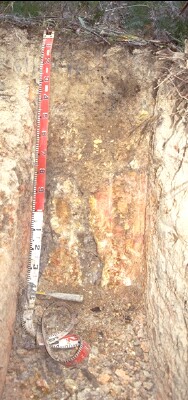 CFTT6 Profile |
| A2 | 10 – 40 cm | Light yellowish brown (10YR6/4), with common, medium, distinct, brownish yellow (10YR6/6) mottles, fine sandy clay loam; massive structure, very firm consistence dry; contains few subrounded, weathered siltstone gravels; pH 5.3; clear and wavy transition to: | |
| Subsoil | |||
| B21 | 40 – 50 cm | Brownish yellow (10YR6/6), with distinct, strong brown (7.5YR5/6) mottles common; light clay (increasing to light medium clay with depth); weak coarse polyhedral structure; very firm consistence moist; coarse subangular and tabular, weathered siltstone gravel common; pH 5.0; clear and wavy transition to: | |
| B22 | 50 – 80 cm | Brown (10YR5/3) with many, coarse, prominent, dark grey (10YR4/1) and yellowish red (5YR4/6) mottles, medium heavy clay; moderate coarse polyhedral structure; strong consistence moist; contains many weathered siltstone cobbles; diffuse and smooth transition to: | |
| B3 | 80 – 130 cm | Red (2.5YR5/6), with many, coarse, prominent, dark grey (10YR4/1) and very pale brown (10YR8/3) mottles; medium heavy clay; moderate very coarse polyhedral structure; strong consistence moist; includes tongues of dark grey heavy clay extending into the decomposing red decomposing fractured rock; abundant cobbles (subangular tabular, weathered siltstone). | |
Key Profile Features:
- Strong texture contrast between surface (A) horizons (<25% clay) and subsoil (B21) horizon (60% clay).
pH | Salinity Rating | |||
Surface (A1 horizon) | Strongly Acid | Very Low | Non-Sodic | None |
Subsoil (B21 horizon) | Very Strongly Acid | Very Low | Non-Sodic | None |
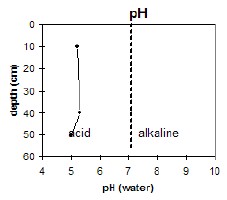 The soil profile is strongly acid to very strongly acid throughout. | 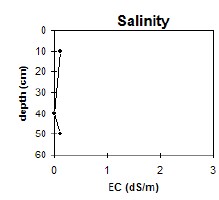 The soil profile has a very low salinity rating throughout. | 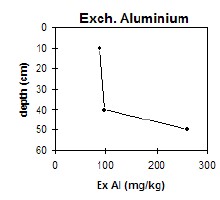 The levels of exchangeable aluminium increase in the very strongly acid subsoil to high levels. | 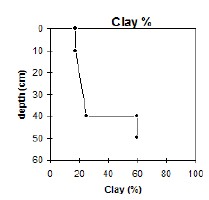 The clay content increases markedly at the A/B horizon interface. |
Horizon | Horizon Depth | pH (water) | pH CaCl2 | EC 1:5 | NaCl | Exchangeable Cations | |||
Ca | Mg | K | Na | ||||||
Meq/100g | |||||||||
A1 | 0-10 | 5.2 | 4.3 | 0.1 | 1.9 | 1.5 | 0.22 | 0.32 | |
A2 | 10-40 | 5.3 | 4.6 | <0.05 | 0.58 | 1.1 | 0.06 | 0.17 | |
B21 | 40-50 | 5 | 4.2 | 0.1 | 0.63 | 7.2 | 0.11 | 0.63 | |
Horizon | Horizon Depth | Ex Al mg/kg | Ex Ac meq/100g | Field pF 2.5 | Wilting Point pF4.2 g/100g | Coarse Sand (0.2-2.0mm) % | Fine Sand (0.02-0.2mm) % | Silt (0.002-0.02mm) % | Clay (<0.002mm) % |
A1 | 0-10 | 88 | 14 | 30.1 | 9.3 | 10.4 | 36.1 | 28.5 | 17.5 |
A2 | 10-40 | 97 | 9.7 | 29 | 9 | 9.6 | 37.4 | 25 | 25 |
B21 | 40-50 | 260 | 13 | 41.6 | 25 | 12.3 | 16.1 | 8 | 59.5 |
Management Considerations:
- The high exchangeable aluminium levels in the very strongly acid subsoil may affect the growth of aluminium sensitive species.
- The subsoil has a very low exchangeable calcium:magnesium ratio (<0.1). Calcium deficiency may result.
- Weathered siltstone impeding at 130 cm. Profile looks like transported material over “breccia” material similar to Cretaceous mudstone, although redder in colour. This soil does not fit the description of Boolarra loam.


